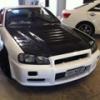Turning A Negative Into A Positive?
Announcements
-
Similar Content
-
Latest Posts
-
Small update for the day... Turns out the intercooler and engine coolant hose kits are anything but complete....I probably should have counted better but it only really covers about half the coolant hoses in the car, it really just covers the visible stuff and pretends everything else doesn't exist (turbo water feed and returns and also heat exchanger lines through the 2 pumps and cooler) .In any case, I'm happier to have half reliable hoses than none, but a bit of a disappointment. Anyway...finger click (and 5 hours).....hoses in place, lots of spring clamps replaced with screw clamps, and engine coolant is on the pressure tester for the night. Incidentally, upsized header tank is an Inifiniti factory option....not sure I'll ever do prod car racing in this but at least it is legal.
-
Just weld it onto the hot pipe. If you want it right after the turbo, put it right after the turbo. Or rip the comp cover off and drill and tap a hole into it.
-
hahaha glad I can rely on you two to go on a spiral at the drop of a problem! Some quick answers....the ducting is excellent top bottom and sides....everything that gets in goes through the coolers (noting the oil cooler redirects it out again, fair call if it is cooling 120o+) and the heat exchanger for the intercooler also has some scoops to pick up more than it's fair share too. I can't see going down the water spray track....no bueno for formal racing and a big risk for long rally days if you run out (plus I'm not clear if it is allowed there either yet). Frankly, it must be possible to reliably put 400kw through a standard front end, the BMWs do it so I just need to work it out....I'm starting with reducing blockages in the way and adding some coolant capacity with a bigger header tank, flushing rad and making sure it was filled/bled properly (I didn't do the last coolant change); also taken measurements incase next step is a bigger/higher capacity custom radiator
-
wow, a completely stock GTR! I've got to admit, I have no idea from what you are describing....do you have any idea where the "thump" comes from, and are you certain it is the HICAS light not something else like the cat overheat light?
-
nice work, welcome to the world of CAD! fabricating accurately in 3 dimensional space is beyond me....I almost always end up making something more than once...sorry I mean I extensively use prototyping
-




Recommended Posts
Create an account or sign in to comment
You need to be a member in order to leave a comment
Create an account
Sign up for a new account in our community. It's easy!
Register a new accountSign in
Already have an account? Sign in here.
Sign In Now